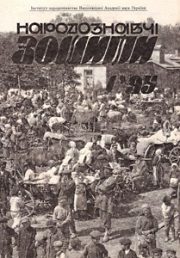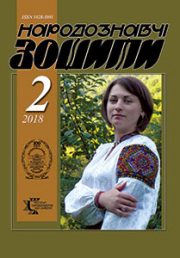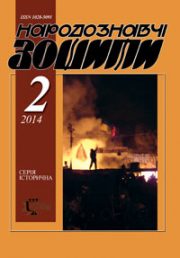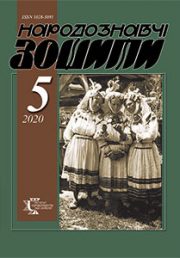The Ethnology Notebooks. 2024. № 1 (175), 189—198
UDK 7.047:656.054/.056:81’373.612.2
DOI https://doi.org/10.15407/nz2024.01.189
BABII Nadiia
- ORCID ID: https://orcid.org/0000-0002-9572-791X
- PhD in Arts, Assistant Professor,
- Vasyl Stefanyc Precarpathian National University,
- 57, Shevchenko street, 76018, Ivano-Frankivsk, Ukraine,
- Contacts: e-mail: nadiia.babii@pnu.edu.ua
Abstract. The article analyzes works/artifacts of visual art that use universal unifying images, namely road signs, as a hybrid or conceptual metaphor.
The aim of the study is to investigate various possible semantic connections between the information sign and the image of the city.
The relevance of the research lies in the fact that the neutrality and uniformity of road signs is a factor in their quick perception and interpretation as a metaphor, including a political one, in works of fine art or in modern practices. The author considers easel painting, photography, collage, assemblage, and practices in public spaces of the late twentieth and early twenty — first centuries.
The research methodology combines the principles of art historical, semiotic, psychological, and cultural methods, which allow us to structure the types of combinations of the image of the city and the road sign, as well as to explain or predict the recipients’ reflection.
Conclusions. The paper proves that the use of off-the-shelf information systems in visual art is one of the infrequent but expressive mechanisms for exploring the themes of everyday life. By incorporating identical signs into urban studies, artists personalize and subjectify the road sign. The materialization of the concept depends on the activity of the viewers who are able to recognize the source and purpose of the metaphor. The concepts we have proposed are not final and can be expanded and supplemented through the publication of other works, viewing the works in other conditions, or by other interpreters who are not connected to the artists mentioned by a common cultural environment. The events of the current historical present prove the significant potential of the road sign as a visual metaphor in the plane of political relations in the space of the modern city. This is the first study in the national scientific discourse devoted to recognizing the purpose of visual metaphors based on navigation objects.
Keywords: image of the city, road sign, visual metaphor, aesthetic consciousness, art of the late twentieth and early twenty — first centuries.
Received 26.01.2024
REFERENCES
- Gibbs, R.W. (1994). The Poetics of Mind. Figurative Thought, Language and Understanding. New York: Cambridge University Press.
- Denisko, P. (2021). Insight. Visual and multimodal metaphors in painting, sculpture, cinema and other visual arts. Poltava [in Ukrainian].
- Neurath, M. & Kinross, R. (2009). The Transformer: Principles of Making Isotype Charts Paperback. Hyphen Press.
- Neborak, V. (1994). Dyskredytatsiia dyskretnosty abo shcho mozhna napysaty pro Yuriia Kokha? Suchasnist (Part 6, pp. 129—134). Retrieved from: https://zbruc.eu/node/91996 11.09.2019 [in Ukrainian].
- Babii, N. (2021). Modification of the city theme in the visual art of western ukraine in the second half of the twentieth century. Ukrainian culture: the past, modern, ways of development. Scientific journals (Issue 38, pp. 45—51) [in Ukrainian].
- (2023, 30.04). Private archive of N. Babii. Nadia Babii with Bronislav Tutelman. (interview) [in Ukrainian].
- (2021, 25.01). Chysta fotohrafiia Viacheslava Tarnovetskoho. Ukrainian photography. Retrieved from: https://www.untitled.in.ua/post/vyacheslav-tarnovetsky-photography
- Drul, O. (2020, 05.01). Nashcho liudiam kartyny. Yurko Kokh. Retrieved from: https://zbruc.eu/node/94689 [in Ukrainian].
- Bobrenko, R. (2020). Artistic Transformation of Road Signs in the Works of Klet Abraham in the Context of Street Art. Artistic Culture. Topical issues, 16 (1), 81—85. DOI: https://doi.org/10.31500/1992-5514.16.2020.205242 [in Ukrainian].
- Jones, J. (2020, 22 Sep.). When does street art become «art» art? Retrieved from: https://www.theguardian.com/artanddesign/2020/sep/22/solved-when-does-street-art-become-art-art
- Denisko, P. (2015). Recognizing the purpose and source of metaphor in visual works of art. Philosophical thought (Issue 4, pp. 104—119) [in Ukrainian].
- (2018, 23.10). This is an upgrade of a road sign in Drohobych by unknown artists. Varto-Halytsia news. Retrieved from: https://www.facebook.com/vartogalnews/posts/pfbid02kKtvGbi17MihJitnLr88As2rfyYjwHHuPmab9QhHswVzhRobSSnAuGwcNGE3fHsdl [in Ukrainian].
- Babii, N. (2021).Popular culture as a source of ideas in the urban spaces of Western Ukraine during the pandemic. Culture and Arts in the Modern World (Issue 22, pp. 129—144). DOI:10.31866/2410-1915.22.2021.235900.
- Toi.khto.dumkamy.bahatiie. Retrieved from: https://www.instagram.com/toy.hto.dumkamy.bahatiye/ [in Ukrainian].
- Koval, V. (2023, 18.08.). V Umani vidbulos vidkryttia art festyvaliu «Svoboda vyboru», yakyi tryvatyme dva misiatsi. Umannews. City. Retrieved from: https://umannews.city/articles/306829/v-umani-vidbulos-vidkrittya-art-festivalyu-svoboda-viboru-yakij-trivatime-dva-misyaci [in Ukrainian].
- Terliuk, I. (2022, 03.03.). Na Ternopilshchyni rozmishchuiut novi dorozhni znaky «Okupantam rukh zaboronenyi». Suspilne Ternopil. Retrieved from: https://suspilne.media/213219-na-ternopilsini-rozmisuut-novi-dorozni-znaki-okupantam-ruh-zaboronenij/ [in Ukrainian].
- Рutler busters. (2022, 03.). Retrieved from:https://milart.ucf.in.ua/murals/putler-busters [in Ukrainian].
- Hal, I. (2022, 3.06.). «U rosiiu nakh*i»: v Ukraini za shaleni hroshi prodaly unikalnyi dorozhnii znak. Fakty. Retrieved from: https://fakty.ua/402059-v-rossiyu-nah-j-v-ukraine-za-beshenye-dengi-prodali-unikalnyj-dorozhnyj-znak [in Ukrainian].







